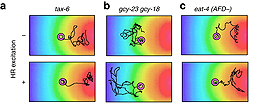Research Abstract
線虫の相反する探索行動を制御する単一感覚ニューロンでの神経情報符号化
複雑な行動に対する神経情報符号を解読することは、神経科学における重要な問題である。
Neural coding in a single sensory neuron controlling opposite seeking behaviours in Caenorhabditis elegans
2011年6月14日 Nature Communications 2 : 355 doi: 10.1038/ncomms1352

複雑な行動に対する神経情報符号を解読することは、神経科学における重要な問題である。線虫(Caenorhabditis elegans)における温度探索行動の神経回路は、ニューロンが行動出力実行のために知覚情報を符号化する仕組みを解明するための理想的な系である。今回我々は、温度感知ニューロンAFDが刺激性および抑制性神経シグナルの両方を単一の介在ニューロンであるAIYに伝達することを示す。この回路では、AFDのカルシウム濃度閾値が相反する神経シグナルに対する切り替えスイッチとして働き、相反する行動を指令する。光駆動イオンポンプとチャネルを使って遠隔操作することにより、AFD活性の低下程度を変化させると、高温領域あるいは低温領域を探索する行動を引き起こせることがわかった。さらにカルシウムイメージングによって、AFDは自身のカルシウム濃度閾値に依存して、刺激性あるいは抑制性の神経シグナル伝達をAIYにもたらすことが明らかになった。すなわち、互いに相反する方向に働く2つの神経制御は、単純な神経回路における行動の逆転と直接連動している。
- 名古屋大学大学院理学研究科
-
科学技術振興機構
*(現)甲南大学理工学部
Unveiling the neural codes for intricate behaviours is a major challenge in neuroscience. The neural circuit for the temperature-seeking behaviour of Caenorhabditis elegans is an ideal system to dissect how neurons encode sensory information for the execution of behavioural output. Here we show that the temperature-sensing neuron AFD transmits both stimulatory and inhibitory neural signals to a single interneuron AIY. In this circuit, a calcium concentration threshold in AFD acts as a switch for opposing neural signals that direct the opposite behaviours. Remote control of AFD activity, using a light-driven ion pump and channel, reveals that diverse reduction levels of AFD activity can generate warm- or cold-seeking behaviour. Calcium imaging shows that AFD uses either stimulatory or inhibitory neuronal signalling onto AIY, depending on the calcium concentration threshold in AFD. Thus, dual neural regulation in opposite directions is directly coupled to behavioural inversion in the simple neural circuit.

